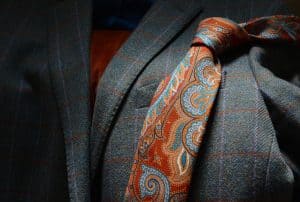The Importance of Color and Contrast, and How to Use Both to Your Advantage

The men who come to BillyGrey are masters of their professions. They’ve succeeded in school and in business, yet they often lack confidence in their appearance! This often has a lot to do with a hesitancy to invest in and wear the color combinations that would make them look their best.
In this guide, we’d like to delve a little deeper into the concept of color contrast.
A Few Basic Tips
First of all, when we talk about color, we’re not just talking about your basic blue, red, gray, etc. We’re talking about different shades of color; we’re talking about particular color combinations that are pleasing to the eye.
We’re also talking about overall style. It might not be appropriate to pair an orange tie with a sky blue shirt in certain settings, or for certain individuals. At BillyGrey, we believe in considering both the man and the situation, and crafting a color palette that’s perfect for both.
A monochromatic palette can be elegant in the right setting – but it can also be boring. Pairing red and green might sound like a holiday party gone bad – but on the right man, it can look like success. It’s all about finding the right look for you.
What a Monochromatic Color Scheme is Really All About
 Let’s go into monochromatic color schemes first. Despite the way it sounds, monochromatic doesn’t necessarily mean “all the same color.” Let’s be frank: it takes real attitude to pull off a black tie paired with a black shirt. What monochromatic actually means is the same hue in slightly different shades. In other words, you find a color that looks great on you, and you use variants of that color to put together a balanced look. Consider, for example, pairing a stylish, navy tie with a light blue shirt.
Let’s go into monochromatic color schemes first. Despite the way it sounds, monochromatic doesn’t necessarily mean “all the same color.” Let’s be frank: it takes real attitude to pull off a black tie paired with a black shirt. What monochromatic actually means is the same hue in slightly different shades. In other words, you find a color that looks great on you, and you use variants of that color to put together a balanced look. Consider, for example, pairing a stylish, navy tie with a light blue shirt.
The monochromatic look is conservative and safe. It’s hard to mess it up. That’s why it works well for a lot of men. If you want to challenge yourself, though, try mixing your wardrobe up with complementary colors
Complementary Colors and How to Use Them
You may not have spent much time in art class, but chances are, you can picture the colors of the rainbow. Imagine those colors in a circle, and you’ve got your standard color wheel:

Complementary colors are opposite one another on the color wheel. That’s why you’ll often see orange paired with blue. As you study color theory, it gets a bit more complicated. The basic premise is that if you have a working knowledge of which colors naturally look more pleasing to the eye, you can pair them in ways that will make a wardrobe really stand out.
Try playing around with complementary colors as you accessorize. You’ll learn fairly quickly that a pocket square or sock in the right shade can add a whole lot of personality to your outfit.
Using Contrast to Your Advantage
The final piece of this color puzzle is contrast. To explain contrast, we generally tell clients to consider a black and white photograph. In black and white, it’s easy to see the contrast in, for example, dark hair and a pale face … or dark skin in a white shirt.
 If you look at the people around you, you’ll notice that some people have a lot of contrast between their hair color and skin color. Others, not so much. What do you see when you look into your mirror? If you’re a Caucasian with blond hair and light eyes, you don’t have as much natural contrast as, say, a light skinned man with black hair.
If you look at the people around you, you’ll notice that some people have a lot of contrast between their hair color and skin color. Others, not so much. What do you see when you look into your mirror? If you’re a Caucasian with blond hair and light eyes, you don’t have as much natural contrast as, say, a light skinned man with black hair.
It’s important to understand what your natural colors are so that you can strive for balance in what you wear. Consider your hair color, eye color, and skin tone and color. If you have low contrast in your hair and face, you should likewise choose low contrast clothing. Too much contrast between what you wear and what you naturally look like can make it seem as though your clothes are wearing you. On the other hand, balancing contrasts by, say, adding a pair of dark-rimmed glasses, can bring harmony back into your entire look.
If you’ve already got high contrast in your hair and face, don’t make yourself look bland by wearing a low-contrast wardrobe. Match your clothing to what you see in the mirror to look more balanced and to display more confidence. Remember: it all starts with you.
Take a look at our video style guide, where Bill Whitney discusses the concept of contrast in more detail.
You’ve Got a Color Expert in BillyGrey
So many men are timid about the clothes they wear, despite having achieved success in all the other areas of their lives. With a little color therapy, however, they can look as good as they feel.
If you’d like a consultation with someone who considers all the attributes that make you you, and dresses you accordingly, give BillyGrey a call.
